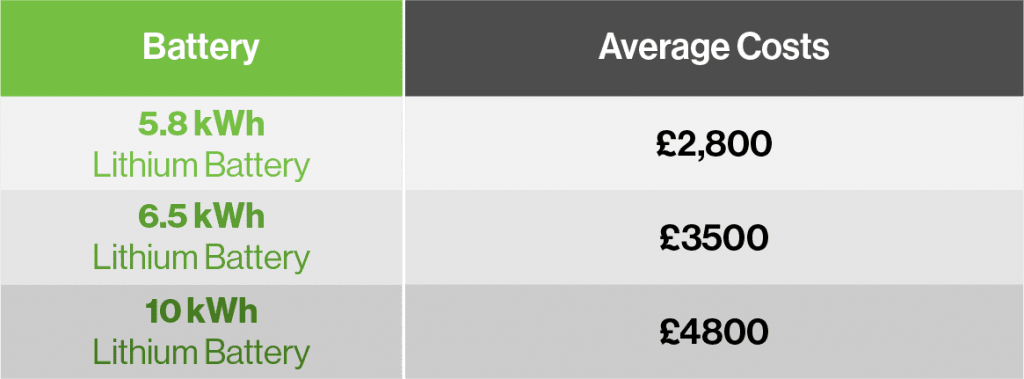Strictly speaking, you don’t need solar battery storage for your system as you can use the energy as it is being produced and any you aren’t using can be sold back to the grid.
It’s much more beneficial to save that energy for yourself and use it after the sun goes down to avoid paying the higher price for using electricity from the grid.
That said, if you want to sell the energy from your batteries you can, and you can still sell any excess electricity you produce after the batteries are fully charged.
It is unlikely, with current technology, to become completely independent from the UK electricity grid, especially in winter, but the time will come when you can – and you’ll need solar battery storage.
So, to sum things up, you need a solar battery storage system because:
-
- You can store energy to use after sunset.
-
- You’ll lower your bill by avoiding peak time rates.
-
- You can sell excess energy back into the grid.
-
- Future proof your home and work towards energy independence.
Selling energy back to the grid got a bad rep years ago as the UK government had set a ridiculously high price for energy sold back into the grid. This caused a lot of problems in the Solar Energy market as 1000s of cowboy companies sprung up and oversold systems to people, promising them untold riches.
Of course, that system was never going to last and now any energy sold to utility companies is sold at a price set by them so it’s obviously at a much lower rate than the energy they sell you.
So, what types of solar batteries are available?
Lithium Ion batteries
Lithium ion batteries are the GOAT of energy storage right now as they have the size, energy capability and price to make them the cost-effective solution.
The development of Lithium Ion has come on in leaps and bounds because of the Electric Vehicle industry. Cars obviously need small, reliable batteries to keep them on the road and as soon as the industry cracked that, the energy sector started to take an interest.
Pros:
-
- Incredibly low maintenance needed.
-
- Higher battery energy density means that Lithium ion batteries hold more energy per cubic centimetre than lead acid batteries.
-
- Lithium Ion batteries offer a high depth of discharge – using more of the energy stored means less recharging.
-
- As they hold more energy they don’t need to charge and discharge as much – so they have a longer lifespan – most companies will guarantee them for at least 10 years.
Cons:
-
- Lithium Ion batteries are more expensive than lead acid batteries.
-
- They can get hot and be subject to a phenomenon called thermal runaway that can be a fire risk. But, if properly installed by a qualified, MSC registered installer, the chance of your battery combusting is close to zero.
Best for:
Lithium ion batteries are the industry standard in domestic solar installations these days. They hold a good charge relative to their size so they are very cost effective so they are great for powering homes.
How much is a solar battery?
As you can see from the price of Telsa Powerwalls, things can get pretty expensive depending on what materials are being used, what extra equipment the battery needs and what name is on the front of the case!
Lithium ion batteries
As these are the ones you are most likely to find in solar power systems then we will look at actual pricing within the market.
Lots of factors will affect the price of Lithium Ion batteries – the brand name, the availability of materials and, of course, the quality of the build.
You can expect to pay between £2000 and £11000 depending on the above, so it’s worth shopping around to get the best value for money.

Do I need more than one solar battery?
This absolutely depends on how much consumption you use in your home, how much power you can generate and how you use the power you have – plus how big the battery is!
This is a good point to look at the way you use energy within your home.
Batteries don’t just have a charge that trickles out every time you turn the kettle on, they also have a load. The load is how much power you use at one time and, the more you load the battery, the quicker it will discharge.
To put this in terms that make sense within the home:
If you come home from work and use the washing machine, oven and dishwasher all at once the battery will run out of charge a lot quicker than if you made dinner … then washed your clothes … then washed the dishes (not necessarily in that order) one after another.
These are things we should all be doing and, when you have a solar storage system, more intelligent use of electricity will become second nature.
Ofgem estimates the typical household in the UK uses 2,900 kWh a year so a 3.2 kWh would be perfectly fine.
You are ideally looking for a battery, or a collection of batteries, that will keep your home going after the sun goes down. The battery slowly drains overnight and is then charged up by the solar panels the next day.
If you have a panel array that produces 3 kWh a day then there is no point having 2 3.2 kWh batteries fitted as one will be more than enough.
What are solar batteries made from?
Solar batteries are made from the same bits and bobs as the batteries in your MP3 player, phone and other electrical items – they are just a lot bigger.
In the UK 99.9% of domestic solar energy installations use Lithium Ion batteries.
Lithium Ion
A Lithium Ion battery contains a plate at each end – one in copper and one in aluminium. The chamber is filled with an electrolyte, or semi-conductive solution, and a porous separator is positioned between the two plates.
One side of the battery contains Lithium metal oxides and the other Lithium metal di-oxides – this creates a potential difference and therefore generates current.
Who installs solar batteries?
Any electrician would be able to install a battery but solar and power storage are a specialist branch of this sector.
Always ensure whoever fits your solar system or batteries is MCS registered.
MCS is an independent body that ensures companies within the renewable energy sector comply to the highest levels in their work, safety and standards.
What is the lifespan of a solar battery?
Solar batteries last a fair bit longer than something like a car or camera battery as they are more carefully monitored.
Most good quality solar batteries will last between 11 and 15 years – and companies generally give you a solar warranty for at least 10 years.
Mis-use of a solar battery will reduce the lifespan though. Basically, a battery’s life depends on how often it is fully charged and discharged.
If your battery isn’t charging and discharging properly the components inside can oxidise or be damaged by heat.
Over charging will create the same problems.
Pros and Cons of installing batteries.
Pros
-
- You can use the electricity you produce rather than sell it back to the grid.
-
- You can still use your energy after the sun goes down.
-
- Sell your excess energy to the grid AFTER you use what you need.
Cons
-
- Can be expensive initially.
-
- Will need replacing after 10 years.
-
- Some suppliers won’t take energy from batteries.
Will a solar battery save me money?
Of course!
The great thing about installing energy storage in your solar system is you should avoid paying premium rates at peak times – and remember, the energy companies pay a lot less for your electricity than you pay for theirs.
The current UK price cap is the highest it’s ever been at 22.36p per kWh as of the Spring 2023 Budget update.
That is soon going to build up and is set to be reviewed in July 2023.
Find out about solar panel finance.
Are there any grants available for solar batteries in the UK?
Simple answer here, no.
Solar grants nearly derailed the industry by offering customers ridiculous prices for ANY electricity they produced when introduced in 2011.
The prices were gradually lowered and then phased out totally to allow energy companies to set the prices – those companies need to make money so they will always pay less than they charge you.
But, all is not lost, domestic systems are completely exempt from VAT and that includes all the bits – from panels to the battery. A 20% saving on any installation.
Businesses can expect to pay 5% VAT for commercial installations.
What other batteries can be used to store your energy?
Lead acid batteries
There are 2 words there that you’re probably going to worry about – lead and acid.
These used to be the tried and tested kind of storage used in solar storage systems, but the technology is pretty outdated so you won’t see many of them around.
Invented in the 1800s, lead acid batteries are ‘deep-cycle’ batteries. This basically means that they can be almost completely discharged, so tend to have shorter lifespans than other batteries.
Unfortunately, they are also prone to over-charging and getting hot, so they can be easily damaged and would need regular check ups and maintenance.
Pros:
-
- Lead acid batteries are cheap as chips.
-
- Old technology so can be easily recycled.
-
- Can be maintained by you.
Cons:
-
- Gets very hot so will need a lot of ventilation.
-
- Will leak if damaged
-
- Need regular maintenance.
-
- Short lifespan of between 5 and 10 years.
Best for:
While lead-acid batteries aren’t the kind of technology we would suggest you use at home, the fact they are so stoic means they are a good option for off-grid solar systems or emergency backup storage in case of a power outage.
Nickel cadmium batteries
More old technology here and another invention from the 1800s, though this time with a super slick 1980s update.
Nickel cadmium (Ni-Cd) batteries are a widely used kind of storage system because they are basically poison! Cadmium is a naturally occurring element that is dangerous to humans, so some countries, in fact most of Europe, have either restricted or banned it.
Because of their unsafe materials Ni-Cd batteries are usually used in very specific areas where they can be regulated and controlled – like aircraft and utility storage facilities.
Pros:
-
- Ni-Cd batteries are incredibly durable – they operate at extreme temperatures.
-
- As the tech is old and simple, Ni-Cd batteries they don’t need complex battery management systems
-
- Maintenance-free and pretty much indestructible.
Cons:
-
- Poisonous!
-
- Banned in some countries and heavily restricted in the UK.
-
- Hard to dispose of/recycle.
-
- Can degrade lowering their ability to hold a charge.
Best for:
Ni-Cd batteries are generally used in industrial or commercial settings where they can be maintained and operated safely.
Flow batteries
Flow batteries are an emerging technology that is becoming more popular, and affordable, with the energy storage sector.
Basically, these little miracles of power storage contain a water based electrolyte flowing between two chambers within the casing. This liquid allows the charged particles to be easily stored and then discharged.
There are some products emerging onto the market now, unfortunately the fact they are significantly bigger than other batteries, as well as being very expensive, makes them impractical for home use.
Pros:
-
- All of the energy stored in the battery can be used so you can completely discharge it without damaging the battery’s health.
-
- Unlike most batteries the insides are fire retardant, which reduces the risk of thermal runaway and increases the lifespan.
-
- Flow batteries live forever! Well, they don’t, but they do go on for 30 years which is pretty much forever in battery terms. The cherry on the Flow Battery cake is they are low-maintenance.
Cons:
-
- Cost – as an emerging technology the design is still being developed and this increases the cost.
-
- They have a fairly low storage capacity in relation to size.
-
- Connected to that is the low charge and discharge rates, which means that to be effective they must be large in size.
Best for:
Flow batteries are generally used in large scale set ups as they are very large themselves. So, industrial power storage, large community solar projects and other big energy users.
It will be a while before flow batteries are used in domestic systems due to their price and size.
Graphene Batteries
Graphene batteries contain sheets of graphene, 2 atoms thick, one positive and one negative, suspended in distilled water. The graphene sheets create a power differential and therefore a current.
As popular northern comedian Peter Kay might say ‘It’s the future!’ but, unfortunately, quite far in the future.
Graphene is a recently developed super material that has a number of amazing properties – including increased storage capacity and reduced heating in batteries.
Graphene is the same material you find in modern pencils – Graphite – but instead of clumping all the atoms together like they are in pencil ‘lead’, the atoms are laid side by side to create the 2D structure of Graphene. This makes the material 100 times stronger than steel – just dropping one layer on top of another creates a structure so strong it can stop a bullet.
Graphene is an amazing conductor and allows batteries to charge and discharge far more than traditional Lithium-Ion batteries. Graphene can also be used in solar panels to increase efficiency and strength.
However, and here’s the rub, a square metre of 2 layer Graphene is currently retailing at around £8,000!
At the moment the graphene itself is far too expensive to use in domestic situations.
Conclusion
Solar energy is fast becoming one of the most popular ways to reduce energy bills and carbon footprints everywhere – from huge factories and warehouses to schools and family homes.
Why is it getting so popular? Rising energy prices, fuel scarcity and other cost of living factors.
Basically, if you can exert a certain amount of control on your energy bills you will feel less worried and stressed about the future.
One way to make a solar energy system even more cost effective is to ensure you have battery storage for your excess energy.







